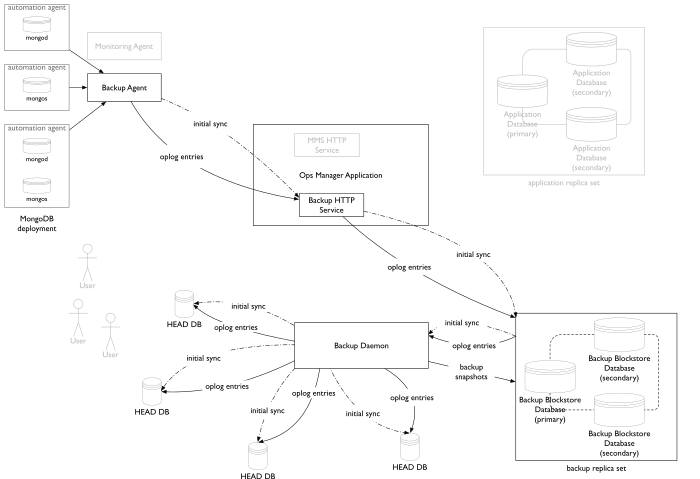- Back Up MongoDB Deployments >
- Backup Flows
Backup Flows¶
On this page
Introduction¶
The Backup service’s process for keeping a backup in sync with your deployment is analogous to the process used by a secondary to replicate data in a replica set. Backup first performs an initial sync to catch up with your deployment and then tails the oplog to stay caught up. Backup takes scheduled snapshots to keep a history of the data.
Initial Sync¶
Transfer of Data and Oplog Entries¶
When you start a backup, the Backup Agent streams your deployment’s existing data to the Backup HTTP Service in batches of documents totaling roughly 10MB. The batches are called “slices.” The Backup HTTP Service stores the slices in a sync store for later processing. The sync store contains only the data as it existed when you started the backup.
While transferring the data, the Backup Agent also tails the oplog and also streams the oplog updates to the Backup HTTP Service. The service places the entries in the oplog store for later processing offline.
By default, both the sync store and oplog store reside on the backing MongoDB replica set that hosts the Backup Blockstore database.
Building the Backup¶
When the Backup HTTP Service has received all of the slices, a Backup Daemon creates a local database on its server and inserts the documents that were captured as slices during the initial sync. The daemon then applies the oplog entries from the oplog store.
The Backup Daemon then validates the data. If there are missing documents, Ops Manager queries the deployment for the documents and the Backup Daemon inserts them. A missing document could occur because of an update that caused a document to move during the initial sync.
Once the Backup Daemon validates the accuracy of the data directory, it removes the data slices from the sync store. At this point, Backup has completed the initial sync process and proceeds to routine operation.
Routine Operation¶
The Backup Agent tails the deployment’s oplog and routinely batches and transfers new oplog entries to the Backup HTTP Service, which stores them in the oplog store. The Backup Daemon applies all newly received oplog entries in batches to its local replica of the backed-up deployment.
Snapshots¶
During a preset interval, the Backup Daemon takes a snapshot of the data directory for the backed-up deployment, breaks it into blocks, and transfers the blocks to the Backup Blockstore database. For a sharded cluster, the daemon takes a snapshot of each shard and of the config servers. The daemon uses checkpoints to synchronize the shards and config servers for the snapshots.
When a user requests a snapshot, a Backup Daemon retrieves the data from the Backup Blockstore database and delivers it to the requested destination. See: Restore Flows for an overview of the restore process.
Grooms¶
Groom jobs perform periodic “garbage collection” on the Backup Blockstore database to remove unused blocks and reclaim space. Unused blocks are those that are no longer referenced by a live snapshot. A scheduling process determines when grooms are necessary.
